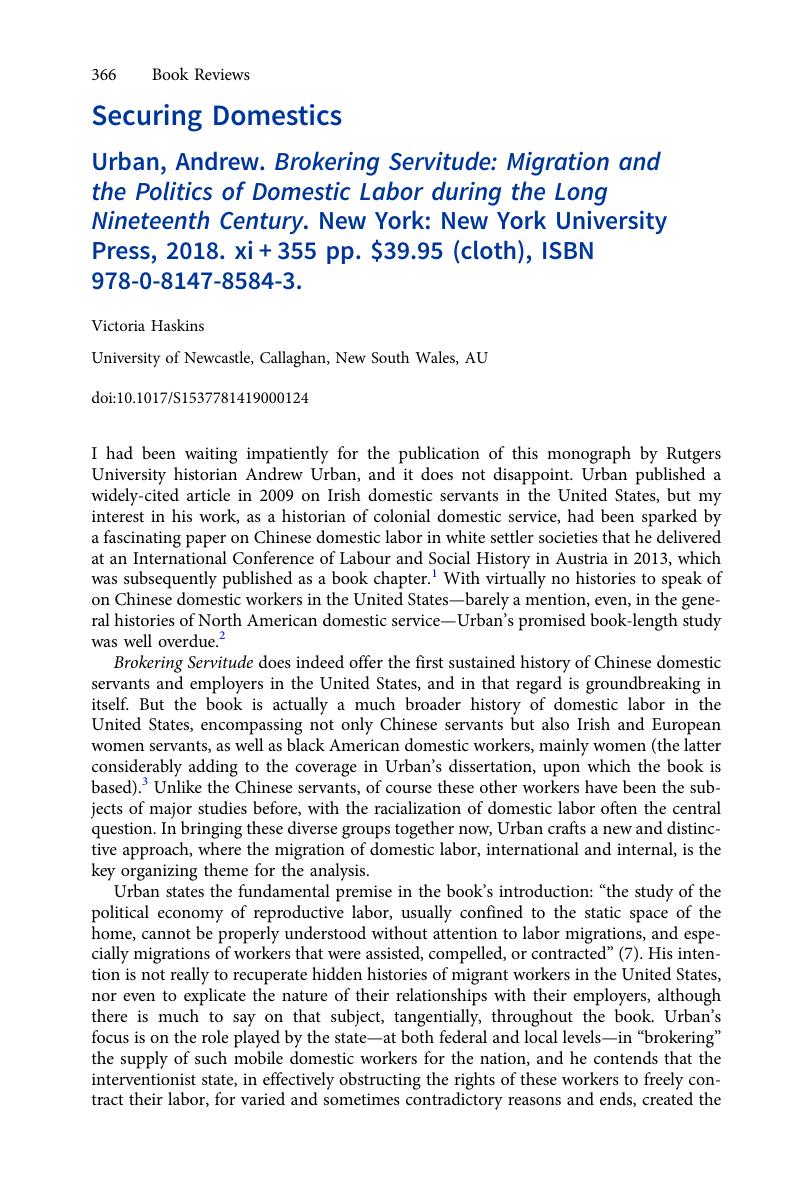No CrossRef data available.
Article contents
Securing Domestics - Andrew Urban. Brokering Servitude: Migration and the Politics of Domestic Labor during the Long Nineteenth Century. New York: New York University Press, 2018. xi + 355 pp. $39.95 (cloth), ISBN 978-0-8147-8584-3.
Published online by Cambridge University Press: 16 July 2019
Abstract

- Type
- Book Reviews
- Information
- Copyright
- Copyright © Society for Historians of the Gilded Age and Progressive Era 2019
References
NOTES
1 Urban, Andrew, “Irish Domestic Servants, ‘Biddy’ and Rebellion in the American Home, 1850–1900,” Gender & History 21:2 (Aug. 2009): 263–86CrossRefGoogle Scholar; Urban, Andrew, “Imperial Divisions of Labor: Chinese Servants and Racial Reproduction in the White Settler Societies of California and the Anglophone Pacific, 1870–1907” in Towards a Global History of Domestic and Caregiving Workers, eds. Hoerder, Dirk, Van Nederveen Meerkerk, Elise, and Neunsinger, Silke (Leiden, The Netherlands: Brill, 2015), 296–322CrossRefGoogle Scholar.
2 For example, see the fleeting references in Katzman, David M, Seven Days a Week: Women and Domestic Service in Industrializing America (New York: Oxford University Press, 1978), 45, 221–22Google Scholar, 257–58; Sutherland, Daniel, Americans and Their Servants: Domestic Service in the United States from 1800 to 1920 (Baton Rouge: Louisiana State University Press, 1981), 5–57Google Scholar; Glenn, Evelyn Nakano, “From Servitude to Service Work: Historical Continuities in the Racial Division of Reproductive Labor,” Signs 18:1 (1992): 1–43CrossRefGoogle Scholar, 9. Outside of Urban's aforementioned chapter, I know of one other sustained study dealing with Chinese domestic servants in the United States itself, O'Neill, Peter D., “Laundering Gender: Chinese Men and Irish Women in Late Nineteenth-Century San Francisco” in The Black and Green Atlantic: Cross-currents of the African and Irish Diasporas, eds. O'Neill, Peter D. and Lloyd, David (Basingstoke: Palgrave Macmillan, 2009), 113–30Google Scholar, but even here the Chinese worker appears mostly as a laundryman, rather than a private household servant. See also, for a brief mention, in the context of the employment of Chinese servants in the Philippines under American occupation, Martínez, Julia and Lowrie, Claire, “Transcolonial Influences on Everyday Imperialism: The Politics of Chinese Domestic Servants in the Philippines,” Pacific Historical Review 81:4 (Nov. 2012): 511–36Google Scholar, 522–23.
3 Andrew Theodore Urban, “An Intimate World: Race, Migration, and Chinese and Irish Domestic Servants in the United States, 1850–1920” (PhD diss., University of Minnesota, 2009).
4 See Magliari, Michael, “Free Soil, Unfree Labor: Cave Johnson Couts and the Binding of Indian Workers in California, 1850–1867,” Pacific Historical Review 73:3 (Aug. 2004): 349–89CrossRefGoogle Scholar, 353; also, Reséndez, Andrés, The Other Slavery: The Uncovered Story of Indian Enslavement in America (Boston: Houghton Mifflin, 2016), 264Google Scholar. Urban makes only a passing reference to Indian domestic labor policies, in the context of federal Indian boarding schools at p. 225.




